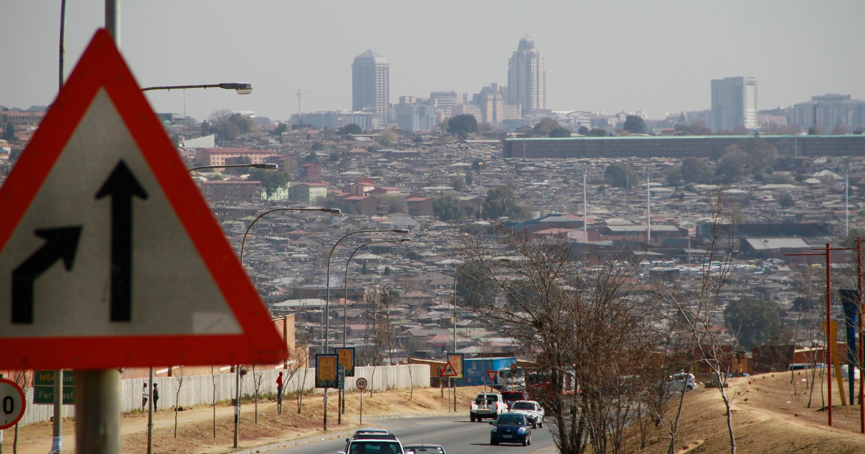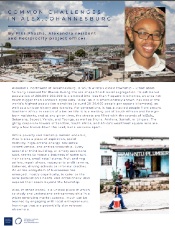About Alex

Alexandra in brief...
History
The development of Alexandra Township dates back to 1912. At the time, it was the only place where black people could buy freehold land. In the 1930’s, the right for black citizens to own property in “white” areas was abolished.
The township has a long and proud history of resistance to apartheid from the very early days. Bus and school boycotts, civil disobedience and sometimes violent confrontations with security forces were common features of life in Alexandra from the 1940s until the 1990s, when white minority rule finally ended. For decades, people lived under threat of forced removals by the authorities: many thousands were moved in the 1960s and 1970s to Soweto, Tembisa and elsewhere. As many people were living in Alexandra without official authorisation, regular police raids were conducted to check people’s papers.
Faced with increasingly militant resistance and the practical impossibility of “removing” Alexandra, the white authorities finally gave up trying in the 1980s. By then, South Africa’s white regime was under siege internally and externally, and getting desperate for a political settlement that would be acceptable to the black majority.
The government tried “winning hearts and minds” with a new “master plan” for Alexandra. For the first time, significant financial resources were set-aside at the beginning of the 80s to develop Alexandra and improve overall conditions. A new area, the East Bank, was built up in 1986 on the other side of the Jukskei River, which runs through the area. Such developments, however, were far from sufficient and failed to address the real needs of the township. In any event, greater political pressures were at play in the country, essentially neutralizing localized measures.
When the main restriction on the movement of black people (influx control) was abolished in 1986, a huge number of people flocked in from the countryside and from neighboring countries in search of work and opportunities. According to some figures, shack numbers tripled from 7,300 in 1987 to 20,000 in 1991.
In the early 1990s the township was wrecked by violence in the run-up to the first democratic elections in 1994. Violence broke out between residents in the men's hostels and residents just south of the hostels, an area that became known as "Beirut". In early 1992 some 60 people were killed, nearly 600 people were injured and around 10,000 people were displaced from their homes.
Today, more than 18 years since the end of apartheid, Alexandra has changed a lot, but kept many features of its early days. Democracy has made people equal in law, but South Africa’s huge inequalities remain largely intact. The contrast is even more glaring in Alexandra than elsewhere in South Africa, as the township is surrounded by some of Africa’s wealthiest communities like Sandton, Kelvin and Wendywood.
Character
Alexandra is famously described by Nelson Mandela in his biography as "exhilarating and precarious". Its people have a very strong feeling of belonging, and throughout its 100-year long history Alex was a nurturing environment for musicians and world famous artists, such as Hugh Masekela and Wally Serote.
The township is quite diverse in its habitat. In some sections narrow alleyways separate overcrowded single-room shacks, and, in a reminder of its farm beginnings, unherded goats scratch for food in the piles of garbage on the streets. In other areas there are hostels of five or six stories, or brightly painted blocks of flats. In signs of increasing prosperity, newer areas look like ordinary suburban streets and houses with the usual high walls and pretty pavement gardens that characterize South African suburbs.
There are about 25 schools, several clinics, taxi ranks, and numerous spaza shops and telephone kiosks supplying basic goods and services. Alex also hosts one cinema, several soccer fields and many churches.
Driving through Alex leaves one with a general impression of ubiquitous poverty witnessed in the many unemployed people milling about the streets, but also of bustling economic activity with thousands of informal retail shops, open-air eating places, hair-salons, etc.
Economic Situation
The township was for many decades known as the "dark city" because it had no electricity. The first house was connected to the grid in the early 1970s. Like many if not most other townships in the country, it is one of the first stops for rural blacks entering the city and looking for work and opportunities.
For decades it had no storm water drainage, resulting in potholes opening up. Communal taps, each serving several households, provided water to homes.
The economic development of Alexandra was severely curtailed by the apartheid state, which provided very limited infrastructure and prevented residents from creating their own businesses. The 1957 Natives (Urban Areas) Consolidation Act and its predecessors restricted residents between 1923 to 1976 to seven self-employment categories in Alexandra itself. Alexandrans could operate general shops, butcheries, and eating-houses, sell milk, vegetables, or hawk goods. The overall number of such enterprises at any time was strictly controlled. As a result, informal trading developed outside the legally recognized activities.
Today, in contrast, you will see how Alexandra’s entrepreneurial spirit has been unleashed: many parts of the town are bustling with road stalls on the pavement selling food, beverages, household items and all manner of other products.
Many parts of Alexandra still rank among the poorest in Johannesburg, but the picture is far from uniform: the township has a complex set of social and economic development requirements.
To know more about Alex, we highly encourage you to read through the two documents below from the Wheeler Institute for Business and Development at LBS.



